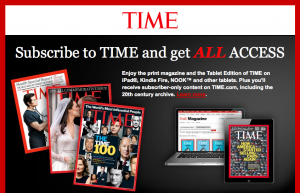As magazines quickly transform themselves from atoms to bits, their basic business strategies are likely to gain greater economic clarity
It is both a difficult and exciting time to be a magazine executive. The nascent tablet revolution has finally given magazine publishers a platform that will allow them to convert their products from atoms to bits. When I first entered the magazine publishing industry in the late 1970s, magazine economics were an odd mix of circulation and advertising revenues. It was considered normal for consumer magazines to generate half their revenue from users and the other half from advertisers. Compare this with the book publishing industry where consumers are the sole source of publisher revenue. Or think about the television industry, where advertising foots the bill.
Over the decades, the large mass circulation magazines that survived the advent of television in the 1960s became oddly more advertising driven, trying to compete directly with the medium that has always distributed its content free of charge. Some might think it ironic that the magazine industry chose to compete with television instead of books, where consumers continue to be the primary source of publisher revenue. Not all publishers veered towards advertising support. The Economist, for example, has continued to focus on readers for the bulk of its revenue. The strategy has worked, with The Economist worldwide circulation now approaching 1.5 million. The Economist has embraced the digital revolution by first building a robust subscription website where only paid subscribers are allowed access to the majority of the content. This clarity of purpose has extended to iPads and other tablet computers with an apt strategy that is also focused solely on paid subscribers. As I mentioned in an earlier post, The Economist offers subscribers a universal digital access policy where a single subscription allows the user to access HTML, print, and digital issue content for a single price via a single user ID and password.
[text_ad]
Why Time magazine should be free
Since the 1960s, Time magazine, like most large US consumer magazines, has pursued a rate base driven business strategy that makes advertising revenue the prime priority. This business strategy has led to lower circulation prices, selling junk circulation, sweepstakes programs, and a myriad of other business practices that a circulation driven magazine would never pursue.
The ultimate low-price strategy: if the executives at Time Inc. continue to pursue an advertising-first strategy, free circulation will clearly generate a rate base far larger than any other pricing strategy, including the $.99 per issue strategy suggested by Steve Jobs.
Engagement is no longer tied to payment: in the old days, magazine executives argued that consumers who paid for magazine subscriptions were more engaged than those who did not. This argument held water in an industry whose engagement metrics were limited to sampling. For digital magazine publishers, engagement metrics are real, detailed, and captured for virtually every reader of every issue.
Bits are cheaper: while the cost of delivering digital magazines is not zero, yet, it is heading in that direction and will reach near zero in a decade or two. As Jeff Bezos is fond of illustrating, the cost of bandwidth and storage has been dropping by about 50 percent annually since the mid-1990s. The trend will likely continue.
So, there you have it. If your goal as a magazine publisher is to maximize your advertising revenue above all other revenues, you will conclude, at some point, that it makes economic sense to give your magazine away for free. The strategy will allow you to reach the largest audience, continue to measure audience engagement, and do so at a minimal cost per additional subscriber.
Niche magazine publishers face harder choices
If you are a publisher of consumer niche magazines where the bulk of your revenue comes from subscription fees, you will likely follow the path of The Economist and not Time magazine. This may not be easy for you. Upstart digital publishers with low overhead and little knowledge of magazine economics will enter the marketplace with free digital magazines. So, it would be a good idea to circle the troops and decide right now whether your future will be advertising or circulation driven. Will you choose a mass circulation strategy that allows you to compete with television and portals for advertising dollars, or will you compete with book publishers who sell users premium long-form high-quality content? Those who cannot choose and reside in the middle will likely be lost.
If you’ve already made this decision, share it with the Mequoda community and I by posting a comment below.




It seems almost obvious.